Hi Guys:
Around 55-60 years ago!!! Solid Scale Modeling Died!!!..at least to the general modeling
public. Plastics came along and everyone jumped in, to the detrimend of All modelers!!! since “making” solid wood models was and is a totally different technique.
Both could have lived very well, but somehow modellers desided to just go “plastic”…so Solid models are “rare” birds today, but really beautiful if you have some patience and like to work with your hands…and also like to “make” one of a kind models. Most Museum models are still “solids” even if today, other materials, are used besides wood. One beauty of this is that you can make any model you ever dreamed of!!!
I will be starting a small 1/72 scale “Dewoitine 510” for the Spanish Civil War GB, there is a pile of them in plastic. It will be an “easy” build, I will make it in Mahogany wood, but other woods are ok, never balsa!!!
If you guys would like to see a “step-by-step” I will gladly make the whole procedure and place it here.
Oh, I just do solids now, my 100+ plastics are in their boxes (since around 1975[xx(][xx(][xx(])
Let me know.[;)]
I’ve seen your work, and it’s admirable. The efforts of any devoted craftsman are very special.
I can’t go as far as you do, but if I never build another fall-together plastic kit, it won’t be too soon. I do nothing but unusual resins and vacuforms now, since I have no interest in building the world’s ten millionth P-51 or Bf-109. How boring is that? Might as well watch TV.
The unfortunate direction modeling is going in–pre-painted photoetch parts, pre-detailed interiors, etc.–was made clear to me when I read an article that said High Planes Models (Australian company) will now sell you not just their kits but totally pre-built, painted and decaled complete models “if you’re short of modeling time.” Costs an extra $100 to $200 depending on the size of the model (all are 1:48 scale).
This is the culture in which, unfortunately, we live. Spectators rather than players. Couch potatoes rather than participants.
Stephan
Yea I would like to see it
Bud
I’d love to see how you do your solid models. Heck I’d even pay to see it, it opens up all kinds of possibilities for modelers who don’t know how. I for one will be in the front seat after seeing what you’ve done here already it can definitely enhance my modeling skills. There are far too many good drawings out there that I’d love to try and model in 1/32nd scale but I don’t have the know how to fabricate the shapes involved. Feed me Seymour Feed Me!!!
I’d be interested. It’s always good to learn new stuff.
Bruce
Hi Tracy, Stephan, Bud and Bruce…
Thanks for your interest. Stephan, vacuforms are somewhat a start for full out “scratchbuilding”, I have done many and still have a bunch of unopened “bags” which I like to take a look once in while and sometimes build one. They are really nice for you can do whatever you want with them in the way of detail.
Hey Tracy, by what you say, I asume you will start work with each step I show!!!..then you can make all those models you been wanting to do[:)]
Bud and Bruce…glad to have you on board…
Hey, 4 out of…neat[yeah]
Please post pics! I would love to see how how you build them.
Solid,
I may not be able to follow but it will definitely show me more than i know about it now or pull my ideas together one of the two I think. Part of the lack of reponse may be because some folks don’t give themselves enough credit as far as thier abilities go in the realm of modeling, heck give it a shot if it doesn’t work out move on but if it does woo hoo!
Tracy
P.S. I’m still wondering what happened to the little RO biplane [:)]
I too would like to see your work. I have built numerous stick and tissue models, as well as the solid wood models, from scratch using the old Cleveland Models plans. The fiinished products are indeed works of art, but that is not to say that the plastic models seen on this forum are any less works of art.
I still do a wood model every so often and have a Piper J-3 Cub waiting for the cockpit to be detailed and then the finishing touches, such as covering and painting, to be done. The parts were cut from balsa sheets, bass wood, bamboo, plywood, and some brass and aluminum sheets and tubing. I decided to use a modern covering material because the old “dope” is very hard to find, and if you do find it the fumes from it are horrible. I have not seen the old Ambroids wood glue or the Pactra “dope” for years. However, the new instant glues work better and do not take many hours to dry. The new covering materials are easy to use and give a much more realistic appearance, and they are less likely to be punctured like the old “silkspan” tissue. The Ex-Acto knife and blades have replaced the single and double edged razors for cutting out balsa parts and carving pieces. The cuts are less frequent, but they are still deep and smart just as much.
The Cub has a six foot wingspan so a solid model is out of the question. I took the 1/32 scale Cleveland Plans and enlarged them on a copy machine and then transferred the formers and ribs, etc. onto balsa and plywood sheets. Parts like the cowling were hand carved from balsa blocks or 1/2" balsa sheet stock glued into blocks. This is the way it was done in the old days. It is enjoyable and satisfying, but it is a different kind of modeling.
I have seen scale flying models that have hand machined scale WORKING engines. The sky is the limit. Does that make building scale plastic models any less an art form? The finished work I see on this forum tells me that the answer to that question is a resounding NO.
Note: The last obstical is to convince the Mrs. to let me hang the Cub in the living room as part of the decor. NOT! Happy modeling, whatever the type of modeling you do.
Here we go…
Scratchbuilding a model airplane takes some research. Today, this is so esy with Internet on 24 hours a day. Once you know which aircraft you want to make you need a lot of photos and a Good Three view Plan with formers ( the contours of the airplane from front to back, wings and tail planes…these are usually shown in the plan by the letters A to…). I also read as much “history” of it as I can since its really nice to know “who was” what you will be making. I gues this is true for all modeling. So the first step for a good final product is good documentation.
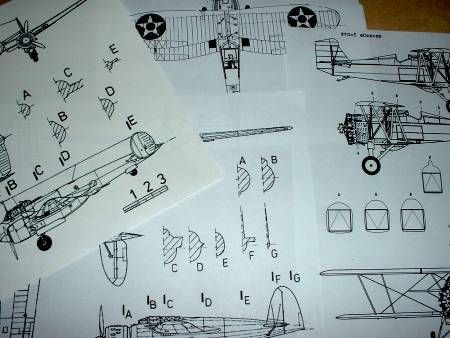
So you have the plan. Now you must deside what Scale you want to do your model and enlarge it to that or leave it as you got it. I do all scales, but the larger the “easier” for detail purposes. 1:32 scale is perfect but eventually will take a lot of space around the house. (You can always give them away as I do [:)]). The one I will be doing here is a 1:72 Scale Dewoitine 510. 1:72 scale is fine and a lot of neat details can be done if you really want to work on it. But you can do any scale…what the heck!!!You are the “maker” not a factory somewhere in the wild blue yonder…[:o)]
Materials::: Here is a good one: Make it out of whatever!!!..have you seen some outstanding paper models?, Foam Balsa?, Vacuform?,I use good old wood. If you make a “hollow” fuselage model you can use balsa but if you are going to to a “solid” model, like we are here, you need some good semi-hard wood like Mahogany (the only one I use) or some of the Pines, but there are many choises. Make sure it is completely dry.
**Tools:…**You will need a hand or electric saw (band) for cutting the contour of your plane from the innitial block of wood, Large files, small files, X-acto type of knives, sand paper from 150 to 2000 or more, good bond paper, file card, plastic card, bamboo sticks ( the barbeque type [%-)]), pins, fast glue, white glue, wood glue,etc…
The list can go on and on but you can be sure you will know what you need when you need it!!![:D]…scratchbuilding is like that, you require and use almost “anything”, you will see as we get into the construction…You Don´t Need Much Money!!![#toast]…scratchbuilding is Cheap!!![party]…its so much fun that even Museums share their treasures with you, for nothing but a few stamps or actually nothing. The National Air and Space Museum in Washington DC and their wonderful staff are responsible for me getting some fantastic plans for Free!!!just for the asking. Try that with a kit manufacturer!!! I once needed really good pics of the old C-46, found them on the Internet from an “accident” reporting Company, sent them an e-mail and they gave me all kind of information on the plane that I would not ever known!!! quite an accident prone aircraft!!![B)]
That´s it, that´s all you need for starters…but you do need one more and probably the most important of all ingredients : Your will and desire to make a unique model!!!trust in yourself that you CAN!!! you can add some patience to it, since you won´t be rushing things and oviously be ready to go back and re-do a part here and a part there after all You are making all the parts!!! Nice[8)]…and hey!!! it´s not hard!!!
PS: Tracy…the little RO-41 is on hold…I usually have3 or 4 projects going at the same time and somehow this little fellow is sitting there waiting for its turn…I´ll have him finished and shinning before the end of the year…nice of you asking, I´ll tell him.[;)]
Hi rangerj: How about showing us your Piper Cub???..sounds like a lot of fun building it. You are so right, it´s a different kind of modeling, I think that´s all…it´s different.
Solid,
I know the old “Cleveland Models” plans are out of business, but I did hear that the plans were sold and are buing reproduced. Do you know anything about this? I haave been looking for a set of plans for an aircraft called the “Joyce-Berliner”, but have been unable to find a set. Do you have any suggestions? This will have to be a scratch build job as no kits have ever been produced. I will try the NASM.
Where do you get your wood. There is a supplier in Texas that sells various types of wood for modeling, such as balsa, bass, plywoods, etc. What are your suggestions? I am looking forward to your posts. Thanks for sharing with us.
rangerj…The “Joyse-Berliner” nice plane…go get it at:
http://www.clevelandairline.com/default.asp
I happen to live in Panama and my friend here I can get almost any wood I want, but I stick to
“Onion Mahogany” for solids, it´s really nice, not to hard, no knots, beautiful finish if you don´t want
to paint the model and it smells great while you work on it. ![]()
Check the Internet, I have seen a lot of places where you can get good wood.What you need? I´ll surf around and let you know.
Now that you have the necessary wood to start the model you start work by taking careful measures of the main parts: Fuselage, wings, and tailfeathers. Carefuly cut up the blocks and planks with your saw.
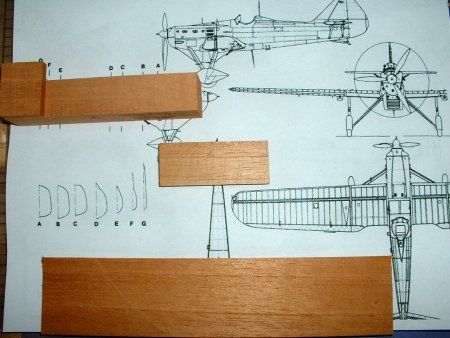
Make a copy of your plan and carefully cut the fuselage contour, wings, tail and elevators and paste them to the wood pieces. Now cut these to the correct shape. You end up with the “Basic” parts to start working on your model. Since I do most of my models this way I have an electric saw, but a small hand saw works just the same, just a little more work.

Now the fun will start.[;)]…Questions anyone?
Thanks solid,
I found the plans I need for the Berliner-Joyce. The old Cleveland Models plans are still being produced and sold. Anyone interested in scale model plans, especially aircraft from the early days of aviation (like the Golden Age of aviation), should visit the web site posted above. The Berliner-Joyce Aviation Company was a short lived company, from about 1929 to 1934. It was bought out by North American Aviation in 1934 IIR. The company produced a few interesting aircraft for the Army, Navy/Marines, and the Coast Guard. I have never ever seen a model of any of the Berliner-Joyce aircraft, and I would guess that 99.9% of this forums readers have never heard of the aircraft or the company. Now I have to decide what scale to build the model. Another large scale model is not an option so 1/32 or 1/24 will be the largest I will go. Solid mahogany would be an interesting project. Solid, I’ll be reading your posts with great interest. This would be a good winter project. Thanks again.
I’ll see if I can get digital pictures of my J-3 Cub and post them.
rangerj… Happy you found the Berliner-Joyce plan. I have many old Cleveland model plans and some “printewood” of their kits. I have made several of them and they are outstanding, full of details, really the plans are works of art.
I made several of them as “solids” and the scale was 1/32. I like mahogany so much that I defently suggest you use that. Last night I looked through my files and found and old 1/72 scale “Berliner Joyse”, perfect for a solid. If you would like it, just let me know and I will send you a copy by e-mail.
Solid,
I’ve got a small stack of the Cleveland plans myself a few birds I’ve been wanting to do something with hence my interest in this thread. As far as wood goes what wood would you recommend for someone here in the states. You said you lived in Panama so I’m assuming the country and not Panama City in Florida. I know you said balsa is out for these projects so would pine be ok?
Tracy
Hi Tracy…If you are going to do a Cleveland plan as a solid I am assuming you will be in
scales 1:32 or 1:48. I use to get good white pine in the US, nice square blocks and all kind
of planks. Pine is fine for solids, just a little bit on the hard side but it only means you will work a little more to get the correct shapes.
Here I am lucky for trees of all kinds are abundant and you can find wood shops that will cut up
any pieces you want for a few dollars. I particularly like Mahogany as you have noticed in the posts.
I am near the left side of this pic.

We now paste the formers to cardboard and cut them for they will be our patters to form the fuselage to its final shape.

You now start “Filing” away at your fuselage carefully checking your work with the formers at their respective stations, this process is just that: Filel & Check, file & check…you will do this until you are satisfied the shape of the fuselage has been acquired…
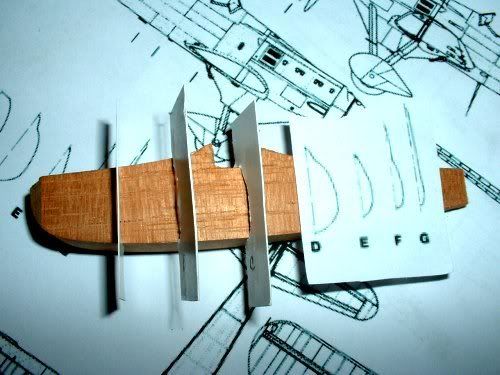
In this particular model I went ahead and glued two pieces of wood on top on the front part of the fuselage to shape into the needed cylinder housings and kept on going, file and check…etc…
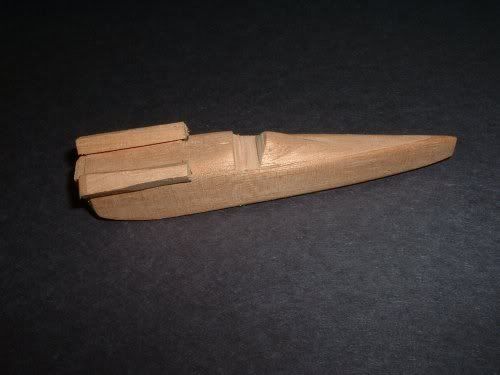
Eventually I got to about 90% of the final shape, but some wood filler was needed to fill some areas plus adding some material where some over filing and sanding had been done. I use the pictured filler which is very good and finishes very nicely.
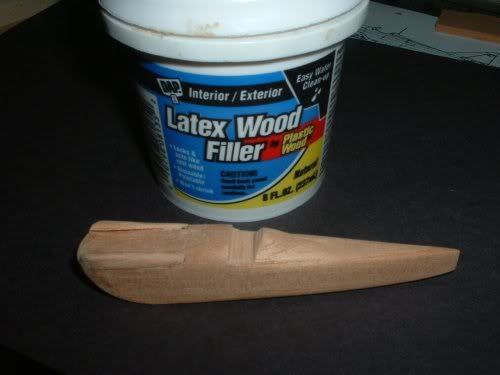
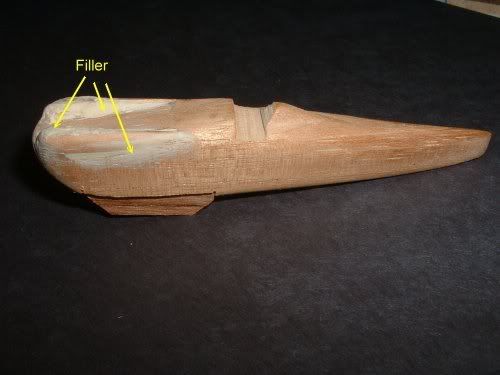
At this stage I checked the fuselage against the plan, was satisfied, and cut the air intake piece and glued to the fuselage front…Here I took a break…[|)]
**ranjerj…**Found this profile of the Berliner Joyse you might like. The site is a gold mine of
profiles.
http://wp.scn.ru/en/ww15/f/744/3/0/1